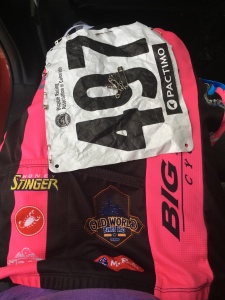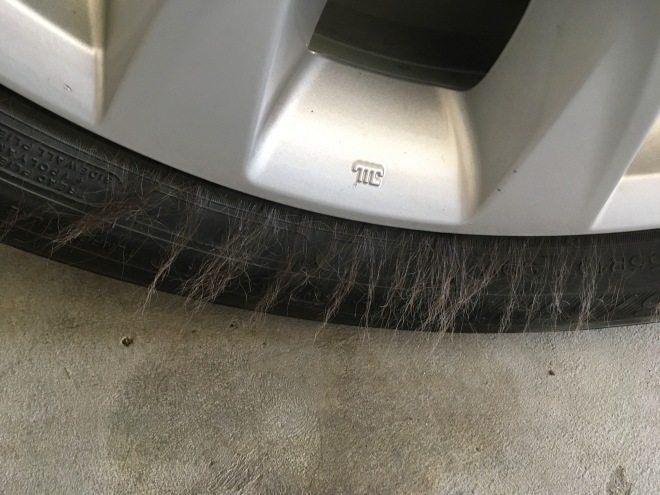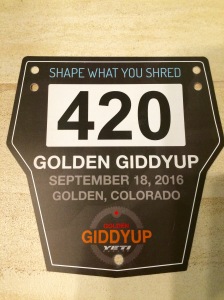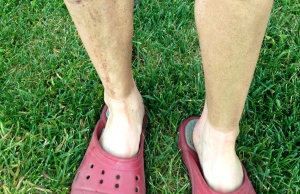As I drove up Highway 72 to Nederland, I wondered just what the course for this inaugural Nederland Cyclocross race would be like. The race flyer stated that the race course would wind through the heart of the town and include a mix of cyclocross features. What exactly, did that description mean? As visions or stairs and other urban cross features floated through my head, I parked and made my way to the registration tent.
The first feature I noticed was a very sharp, uphill turn onto a covered pedestrian bridge over a creek. After retrieving my race number, I walked a bit more of the course. I noticed another bridge and some railroad tie barriers. I made some smalltalk with a woman nearby. The topic of conversation quickly came around to the race course. She mentioned on the other side of the course, that if you didn’t take the right line in one section, you were sure to end up in the lake.
At that point I decided it was in my best interest to get my bike out of the car and take a pre-ride of the course. I didn’t mind getting dirty, but I certainly did not want to land in a lake astride my bike. Once the current race was over, I pedaled on to the course. I ended up behind another guy who must have already raced, because as we rode along, he told me about what was coming up around each bend. In this section of the course that wound along the creek, the vegetation was so tall that you couldn’t see what was coming until you were there. The first surprise was a sharp left turn. The next surprise was a path of beaten down cat tails. The mud below the cat tails was now being churned up by all the bike tires. At the end of the cat tails was a steep run-up.
The next part of the course was the hard part: two- three off-camber ups and downs on loose dirt, and the steepest, loosest run-up ever. This was followed by the steepest, loosest descent ever seen (by me!) on a cyclocross race course. It was during this descent that I came upon the place where landing in the lake was supposedly a certainty if one were to take the wrong line. My conclusion was that landing in the lake was only a remote possibility under the worst set of circumstances. At the end of the lap, I began to question whether this race was something I could actually finish, let alone be competitive in. I’d been nursing a sore shoulder all week and it would be impossible for me to shoulder the bike in any of the sections where it would make sense to do so. I’d have to run the bike and lift it over the barriers when necessary. I considered packing my bike in the car and going home right then and there. Then my phone rang and Motoman wanted to know if it was raining in Nederland? I looked up at the threatening skies and thought how miserable this course would become if the skies were to let go.
When Motoman arrived, I mentioned how hard the course was and that I was  contemplating leaving. His response was that it would be just as hard for everyone else as it would be for me. As I pinned the number to my jersey, I thought to myself that I’ll just ride it; then I won’t have any expectations nor disappointment about how I finish. Then we got a FaceTime call from our daughter who we hadn’t spoken to in a couple of days. It proved to be the perfect distraction. When we hung up, I had only about 30 minutes before the start time to pedal around and half-heartedly warm-up. Besides, who needs to warm-up for ride??
contemplating leaving. His response was that it would be just as hard for everyone else as it would be for me. As I pinned the number to my jersey, I thought to myself that I’ll just ride it; then I won’t have any expectations nor disappointment about how I finish. Then we got a FaceTime call from our daughter who we hadn’t spoken to in a couple of days. It proved to be the perfect distraction. When we hung up, I had only about 30 minutes before the start time to pedal around and half-heartedly warm-up. Besides, who needs to warm-up for ride??
Promptly at 5:10 PM, the race started and we were off! Racers were still rather clumped together when I reached the hard part of the course. A crash in front of me forced me off the bike and to run more of the off-camber section than I would have liked. However, as I trotted along, I realized that the women who were riding weren’t going any faster than I was. I had started to run with my bike because I didn’t want to stop. But now that I couldn’t find a decent place to remount, I just kept going. Two thoughts occurred to me as I finished that first lap 1) I did not want to run as much on the next lap and 2) this race was as hard for the other women as it was for me!

Photo Credit: Cid Dennis
I dug in and settled into a pace I could sustain for five more laps. I’m so proud to have finished such a difficult race! Taking 2nd place was the icing on the cake!
Not only was this the hardest race I’ve finished, it was also the most expensive:
- Entry fee: $30
- Deductible for car repairs necessary from colliding with black bear on the way home: $750
- While tasty, the six pack of beer only drowned my sorrows temporarily.

Master’s Women 40+, 2nd Place Photo by: Cid Dennis

That’s black bear fur stuck in the wheel.


 After all the effort that we’d put into transferring the race entry, I was somewhat surprised that my name was, in fact, on the racer’s list at packet pickup. The bigger surprise, however, was my race number. Yep, I was lucky
After all the effort that we’d put into transferring the race entry, I was somewhat surprised that my name was, in fact, on the racer’s list at packet pickup. The bigger surprise, however, was my race number. Yep, I was lucky 












 in the first place. I was 37 miles into the Firecracker 50 when I was offered my choice of cold beers for the ride down the service road. Heineken never tasted so good, and I didn’t spill a single drop on that bumpy road, steering my bike one-handed.
in the first place. I was 37 miles into the Firecracker 50 when I was offered my choice of cold beers for the ride down the service road. Heineken never tasted so good, and I didn’t spill a single drop on that bumpy road, steering my bike one-handed.